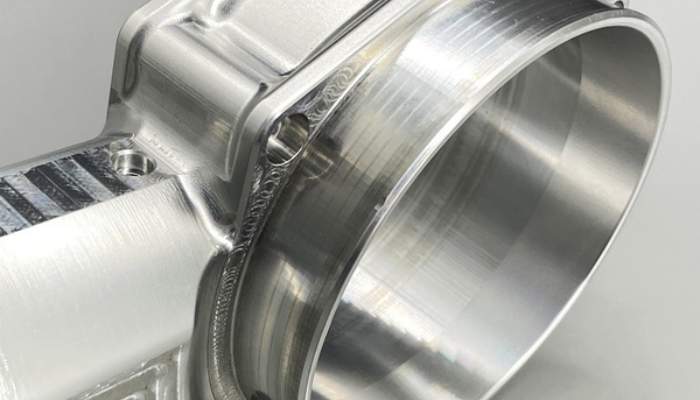Prototype CNC machining is a vital step before high-volume production. The program is controlled by engineers on the computer, and the tolerance can reach ±4 μm, which meets the production requirements of most CNC machining prototype parts
. Compared with the traditional forging and casting process, hand CNC machining can realize the rapid design of 3D parts and high-precision production of machined parts, effectively improve the production efficiency of machined parts, shorten the delivery cycle, and is an ideal choice for hand parts processing.
Technologies For Prototype CNC Machining
CNC Milling Machining
The processing technology of using end mills, face mills, ball end mills, and other rotating tools to cut metal or other processed materials on prototype CNC milling machines is called CNC milling. Applications include automotive machined parts such as cylinder heads, suspension components, and intake manifolds.
Sheet Metal Fabrication
Sheet metal prototype processing includes sheet metal cutting, bending, forming, deburring, and other processing steps. Its processing applications include the production of electronic brackets, enclosures and chassis, and electrical boxes.
CNC 5-Axis Milling
CNC 5-axis milling is a machining process in which the cutting tool rotates around five different axes of motion to remove material from the workpiece. Its applications include the automotive industry, such as control arms, spindles, steering knuckles, and other components.
Custom Rapid Prototyping
Manufacturers usually use custom rapid prototyping processing technology to meet the processing needs of quickly creating prototype part models. Its applications include industrial equipment: gears, bearings, valves, and pumps.
Laser Cutting
Laser cutting is the computer-controlled use of high-powered lasers to cut and shape machined parts from materials. Its applications include aerospace components such as turbine blades, fuel nozzles, and structural components.

Advantages Of Prototype CNC Machining
Accuracy
Accurately completing the part processing standards required by the manufacturer has always been an advantage of prototype CNC machined parts.
Flexibility
Prototype CNC satisfies the characteristics of flexible processing and accepts the manufacturing requirements of complex parts and the material tolerance of processing.
High Efficiency
Prototype CNC processing is computer-controlled processing. After the program is set by the engineer, the tool can be processed repeatedly along the trajectory, without manual re-operation, which greatly reduces the time and shortens the delivery time.
Quality
Real-time processing monitoring, digital processing operations, and high-precision processing operations are the bishop of prototype CNC processing.
Cost-Effectiveness
Prototype CNC machining realizes the digital design of the processed parts and the precise processing of processing process through CNC equipment, reducing the cost of rework and waste of processing materials.
Limitations Of Prototype CNC Machining
Material Restrictions:
The final processing effect will vary depending on the material of the processed parts. For example, the processing time and cost of alloy materials with high melting points will be difficult to calculate and grasp.
Size Restrictions:
When we are processing, the size is also a consideration, Large-scale processing parts need to consider other professional processing techniques and equipment.
Complexity Constraints:
Complex machined parts require an iterative design to meet the requirements of the fabricator and prototype CNC machining technology. Not suitable for mass production and requires long lead times
Application Of Prototype CNC Machining
Application of prototype CNC machining parts in the industry as below :
Aviation Industry
This industry requires sophisticated parts to ensure the safe operation of aerospace equipment. Its applications are turbine blades of aircraft engines, engine components, and structural elements.
Automotive Industry
The fast-changing automotive industry requires multiple iterations in component design. Its applications are engine components, gearboxes, and suspension components.
Electronics Industry
The processing of electronic components is often complex and delicate, and manufacturers usually choose prototype CNC processing for processing. Its applications include electronic circuit boards, microchips, and electronic connectors.
Construction Industry
In the construction industry, our first consideration is safety and quality assurance, the two are indispensable, and the prototype processing parts have small tolerances and high precision to meet your needs. Therefore, we often use prototyping to create a physical model of the design. Designers can realize their own ideas through model-making. In this way, designers can make their designs perfect, thereby reducing time and cost for construction companies.
Materials Suitable For Prototyping CNC Machining
Metals: Stainless steel, Aluminum, Steel, Brass, Carbon Steel, Copper, Titanium, Nickel, and Metal Alloys
Plastic: ABS, Polycarbonate, Polypropylene, Acrylic, Nylon, Polycarbonate, Polyethylene, PVC, POM
Composite materials: glass fiber, carbon fiber, glass fiber, Kevlar
Ceramics: alumina, zirconia
Tirapid Prototyping CNC Machining Parts
Tirapid is an expert in rapid prototyping cnc making with expertise and extensive project experience in CNC machining services. Contact us today for a free quote.


